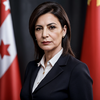1731 Sanaman general election: Difference between revisions
No edit summary |
No edit summary |
||
| (One intermediate revision by the same user not shown) | |||
| Line 9: | Line 9: | ||
| next_election = 1735 Sanaman general election | | next_election = 1735 Sanaman general election | ||
| next_year = 1735 | | next_year = 1735 | ||
| seats_for_election = All | | seats_for_election = All 512 seats of the House of People's Delegates <br> '''257 seats''' needed for a majority | ||
| election_date = 12.X.1731 | | election_date = 12.X.1731 | ||
| turnout = <!--77,612,212 (88.73%) 69,954,061 (82.63%) 72,104,821 (87.08%) 70,080,261 (87.13%) 67,549,866 (86.72%)--> | | turnout = {{decrease}} 71,093,601 (71.62%) <!--77,612,212 (88.73%) 69,954,061 (82.63%) 72,104,821 (87.08%) 70,080,261 (87.13%) 67,549,866 (86.72%)--> | ||
| image1 = [[File:Toti Lampa.png|100px]] | | image1 = [[File:Toti Lampa.png|100px]] | ||
| Line 21: | Line 21: | ||
| seats1 = '''409''' | | seats1 = '''409''' | ||
| seat_change1 = {{increase}} 111 | | seat_change1 = {{increase}} 111 | ||
| popular_vote1 = <!-- 31,614,256 2,434,895--> | | popular_vote1 = {{increase}} 40,025,697 <!-- 31,614,256 2,434,895--> | ||
| percentage1 = <!-- 40.73% --> | | percentage1 = {{increase}} 56.30% <!-- 40.73% --> | ||
| swing1 = | | swing1 = | ||
| Line 33: | Line 33: | ||
| seats2 = 62 <!--21 38 '''259'''--> | | seats2 = 62 <!--21 38 '''259'''--> | ||
| seat_change2 = {{increase}} 41 | | seat_change2 = {{increase}} 41 | ||
| popular_vote2 = <!--{{decrease}} 13,717,422{{increase}} 29,744,467; 22,360,643; 20,414,380; 16,763,193--> | | popular_vote2 = {{increase}} 26,496,585 <!--{{decrease}} 13,717,422{{increase}} 29,744,467; 22,360,643; 20,414,380; 16,763,193--> | ||
| percentage2 = <!--{{decrease}} 11.06%{{increase}} 42.52%; 31.28%; 29.13%; 24.64%--> | | percentage2 = {{increase}} 37.27% <!--{{decrease}} 11.06%{{increase}} 42.52%; 31.28%; 29.13%; 24.64%--> | ||
| swing2 = <!--{{decrease}} 31.46%{{increase}} 11.24%--> | | swing2 = <!--{{decrease}} 31.46%{{increase}} 11.24%--> | ||
| party3 = Minor parties | | image3 = [[File:Gjorgja Calanutti.png|100px]] | ||
| | | leader3 = Gjorgja Calanutti | ||
| | | party3 = Partito Popolare Cisamarrese | ||
| | | alliance3 = | ||
| | | last_election3 = ''New'' | ||
| | | leaders_seat3 = Acquecalde 1 | ||
| | | seats3 = 20 | ||
| seat_change3 = {{increase}} 20 | |||
| popular_vote3 = {{increase}} 2,619,064 | |||
| percentage3 = {{increase}} 3.68% | |||
| swing3 = | |||
| party4 = Minor parties | |||
| last_election4 = 12<!--12 14--> | |||
| seats4 = 12 <!--12 12--> | |||
| seat_change4 = 0 <!--0--> | |||
| popular_vote4 = {{increase}} 1,437,599 <!--2,434,895 {{decrease}} 2,371,443; 3,424,414; 2,305,641; 2,517,657--> | |||
| percentage4 = {{increase}} 2.02% <!--3.14% {{decrease}} 3.39%; 4.79%; 3.29%; 3.32%--> | |||
| swing4 = <!--{{decrease}} 1.40%; 1.50%; 0.03%--> | |||
| map_image = <!--SNM_1723_elections.png--> | | map_image = <!--SNM_1723_elections.png--> | ||
| Line 58: | Line 70: | ||
The '''{{PAGENAME}}''' took place on 12.X.1731, to elect two of three houses of the [[Lhusan Nasyonal]]. About a month before the election, the [[National Judex of Sanama|National Judex]] banned the [[Party of Democratic Humanism]] due to its involvement in the [[1731 Cisamarrese insurrection]]. Its leader, [[Darius Hosseini]], had already defected to the [[Benacian Union]], and with several center-right and right wing parties having merged into the party after the 1727 election, the campaign was blindsided by the ruling. With the deadline for registering parties and candidates having already passed, all candidates for the Humanists were inelligible for election on the party ticket overnight. This left the [[Agrarian League]], Citizens United and the Democratic Nazarene Union on the political right, with only the first party with any reasonable chance of winning seats. Both the government and the National Judex were heavily criticised by the right, calling the banning of the PDH a "political hitjob". Qukalsim [[Toti Lampa]] fired back saying that it should be self-evident that parties engaging in insurrection should not be allowed to participate in elections. The majoritarian electoral system prevented several minor parties from getting into the House of People's Delegates. | The '''{{PAGENAME}}''' took place on 12.X.1731, to elect two of three houses of the [[Lhusan Nasyonal]]. About a month before the election, the [[National Judex of Sanama|National Judex]] banned the [[Party of Democratic Humanism]] due to its involvement in the [[1731 Cisamarrese insurrection]]. Its leader, [[Darius Hosseini]], had already defected to the [[Benacian Union]], and with several center-right and right wing parties having merged into the party after the 1727 election, the campaign was blindsided by the ruling. With the deadline for registering parties and candidates having already passed, all candidates for the Humanists were inelligible for election on the party ticket overnight. This left the [[Agrarian League]], Citizens United and the Democratic Nazarene Union on the political right, with only the first party with any reasonable chance of winning seats. Both the government and the National Judex were heavily criticised by the right, calling the banning of the PDH a "political hitjob". Qukalsim [[Toti Lampa]] fired back saying that it should be self-evident that parties engaging in insurrection should not be allowed to participate in elections. The majoritarian electoral system prevented several minor parties from getting into the House of People's Delegates. | ||
== Constituencies per people's republics == | |||
{| class="wikitable" | |||
! People's republic !! Constituencies | |||
|- | |||
| Ailan Feq || 5 | |||
|- | |||
| Amarra Esa || 25 | |||
|- | |||
| Cisamarra || 29 | |||
|- | |||
| Estarisa || 3 | |||
|- | |||
| Fatehpur Sikri || 62 | |||
|- | |||
| Harekina || 26 | |||
|- | |||
| Indipendensa || 31 | |||
|- | |||
| Kortilhera || 28 | |||
|- | |||
| Laq Republic || 6 | |||
|- | |||
| Niyi || 105 | |||
|- | |||
| Panetira || 32 | |||
|- | |||
| Pixa Teta || 40 | |||
|- | |||
| Sanilla Ate || 32 | |||
|- | |||
| Sanilla Senter || 28 | |||
|- | |||
| Semisa || 29 | |||
|- | |||
| Semisa City || 3 | |||
|- | |||
| Soli || 28 | |||
|- | |||
! Sanama !! 512 | |||
|} | |||
== Aftermath == | == Aftermath == | ||
The controversies surrounding the election forced Qukalsim Lampa to address the shortcomings of the political system. With his massive supermajority, he pledged to reform Sanaman democracy by changing to proportional voting and reducing the Lhusan Nasyonal to a bicameral parliament by removing the House of Councillors and making the Council of People's Republics directly elected as well. A more controversial proposal was to create a supervisory council, to provide a more long-term vision and agenda for the governance of the country. | The controversies surrounding the election forced Qukalsim Lampa to address the shortcomings of the political system. With his massive supermajority, he pledged to reform Sanaman democracy by changing to proportional voting and reducing the Lhusan Nasyonal to a bicameral parliament by removing the House of Councillors and making the Council of People's Republics directly elected as well. A more controversial proposal was to create a supervisory council, to provide a more long-term vision and agenda for the governance of the country. | ||
Latest revision as of 20:38, 23 June 2024
| ||||||||||||||||||||||||||||||||||||||||||||||||||||||||||||||
All 512 seats of the House of People's Delegates 257 seats needed for a majority | ||||||||||||||||||||||||||||||||||||||||||||||||||||||||||||||
|---|---|---|---|---|---|---|---|---|---|---|---|---|---|---|---|---|---|---|---|---|---|---|---|---|---|---|---|---|---|---|---|---|---|---|---|---|---|---|---|---|---|---|---|---|---|---|---|---|---|---|---|---|---|---|---|---|---|---|---|---|---|---|
| Turnout | ▼ 71,093,601 (71.62%) | |||||||||||||||||||||||||||||||||||||||||||||||||||||||||||||
|
| ||||||||||||||||||||||||||||||||||||||||||||||||||||||||||||||
| ||||||||||||||||||||||||||||||||||||||||||||||||||||||||||||||
The 1731 Sanaman general election took place on 12.X.1731, to elect two of three houses of the Lhusan Nasyonal. About a month before the election, the National Judex banned the Party of Democratic Humanism due to its involvement in the 1731 Cisamarrese insurrection. Its leader, Darius Hosseini, had already defected to the Benacian Union, and with several center-right and right wing parties having merged into the party after the 1727 election, the campaign was blindsided by the ruling. With the deadline for registering parties and candidates having already passed, all candidates for the Humanists were inelligible for election on the party ticket overnight. This left the Agrarian League, Citizens United and the Democratic Nazarene Union on the political right, with only the first party with any reasonable chance of winning seats. Both the government and the National Judex were heavily criticised by the right, calling the banning of the PDH a "political hitjob". Qukalsim Toti Lampa fired back saying that it should be self-evident that parties engaging in insurrection should not be allowed to participate in elections. The majoritarian electoral system prevented several minor parties from getting into the House of People's Delegates.
Constituencies per people's republics
| People's republic | Constituencies |
|---|---|
| Ailan Feq | 5 |
| Amarra Esa | 25 |
| Cisamarra | 29 |
| Estarisa | 3 |
| Fatehpur Sikri | 62 |
| Harekina | 26 |
| Indipendensa | 31 |
| Kortilhera | 28 |
| Laq Republic | 6 |
| Niyi | 105 |
| Panetira | 32 |
| Pixa Teta | 40 |
| Sanilla Ate | 32 |
| Sanilla Senter | 28 |
| Semisa | 29 |
| Semisa City | 3 |
| Soli | 28 |
| Sanama | 512 |
Aftermath
The controversies surrounding the election forced Qukalsim Lampa to address the shortcomings of the political system. With his massive supermajority, he pledged to reform Sanaman democracy by changing to proportional voting and reducing the Lhusan Nasyonal to a bicameral parliament by removing the House of Councillors and making the Council of People's Republics directly elected as well. A more controversial proposal was to create a supervisory council, to provide a more long-term vision and agenda for the governance of the country.


